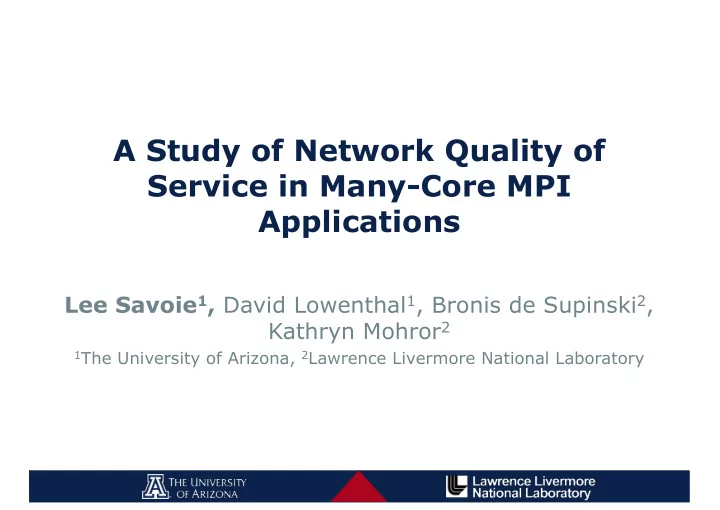

A Study of Network Quality of Service in Many-Core MPI Applications Lee Savoie 1 , David Lowenthal 1 , Bronis de Supinski 2 , Kathryn Mohror 2 1 The University of Arizona, 2 Lawrence Livermore National Laboratory
Introduction Core counts increasing in high performance computing • (HPC) Many machines already include many-core accelerators • Many-core nodes process more data • The network must work harder to transfer data between • nodes 2
Network Contention “There goes the neighborhood: performance degradation due to nearby jobs” (Bhatele et al., SC 13) 3
Fat-tree Contention HPC systems with many-core nodes need better network • management 4
Quality of Service (QoS) Most networks provide QoS mechanisms for network • management In Infiniband: • Packets are marked with a service level (SL) • Each SL has a priority • SL 1, priority 1 Network SL 2, priority 3 5
Research Question Can we improve the performance of contending jobs on • HPC systems using QoS? This will enable HPC systems to handle the increased data demands of • many-core nodes. This work focuses on per-job QoS • Each job runs in a separate service level • Each job is guaranteed a minimum amount of bandwidth • 6
Experimental Set Up 300 node machine • Left 20 nodes free in case of failures • No other jobs running • Service levels with priorities 2286:254:9:1 • Applications • QBox • Crystal Router • MILC • pF3D • Micro-benchmarks • 7
Micro-Benchmarks Flood-Pairs Nearest-Neighbor All-to-all Random-Pairs 8
Methodology Ran 4 jobs at a time • 70 nodes each • 22 ranks per node • Assigned nodes to jobs randomly • Repeated tests several times with different node assignments • Restarted each job when it completed to maintain • contention profile until all jobs completed at least once Ran the following tests • Ideal – each job running in isolation • Default – all jobs in the same service level • All assignments of jobs to 4 service levels • 9
Results: Micro-Benchmarks Per-job QoS is insufficient to improve performance. • 10
Flood-pairs Rank Timing Only a few ranks need to be prioritized. • 11
Nearest-neighbor Rank Timing High Priority Contended 12
Nearest-neighbor Rank Timing High Priority Contended 13
Nearest-neighbor Rank Timing High Priority Contended 14
Nearest-neighbor Rank Timing High Priority Contended 15
Nearest-neighbor Rank Timing High Priority Contended 16
Nearest-neighbor Rank Timing High Priority Contended 17
Per-Rank QoS Prioritizing an entire job gives high priority to some ranks • that are already fast. This slows down other jobs, erasing any throughput • improvement. What if we prioritize only the slowest ranks? • Requires prioritizing only ~10% of ranks • Same performance as prioritizing the entire job • Expect significant reduction in impact on other jobs • This is the subject of ongoing research • 18
Related Work QoS has been studied for a long time • Jokanovic et al. (2012) came to opposite conclusions • Segregate jobs into SLs with different priorities • 59% contention reduction • Possible reasons for the difference: • Simulation vs hardware • Future vs current hardware • Different service levels • 19
Different Service Levels QoS in HPC deserves more research • 20
Conclusion Many-core nodes will require efficient networks to move • data around Simple, per-job QoS is unlikely to improve performance • Differs from previous work • Per-rank QoS is more promising • Further research is needed to understand QoS in HPC • lsavoie@cs.arizona.edu http://www.cs.arizona.edu/people/lsavoie/ 21
Backup 22
Per-Job QoS No QoS: Job 1 Job 2 Network Job 3 QoS: Job 1, priority 1 Network Job 2, priority 3 Job 3, priority 2 23
Related Work QoS has been applied to: • The internet [Blake 1998] • Video streaming [Ke 2005, Kumwilaisak 2003] • Clouds and data centers [Voith 2012] • Wireless networks [Andrews 2001] • Divide traffic across SLs with the same priority to avoid • head of line blocking [Subramoni 2010, Guay 2011] We use service levels with different priorities • Other methods of dealing with contention • Adaptive routing [Jain 2014] • Job placement [Yang 2016, Jokanovic 2015] • These methods are complimentary to ours and insufficient on their • own 24
Results: Applications Per-job QoS is insufficient to improve performance. • 25
Recommend
More recommend